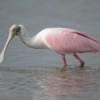 By Jim Stevenson
By Jim Stevenson
First, I am kinda excited about birding this weekend, with a frontal system passing tonight. We will probably get our last real songbird migrant push of the year, as well as other migrants like falcons, waterfowl and whatever. Try to get out and do some birding if you can. (I told the NCAA to make the #5 FSU vs. #3 Clemson game at night so the entire Nation wouldn’t miss the birding!) If you are inclined, we have lotsa room for both Saturday and Sunday morning’s field trips. Write for information. You guys have a good weekend.
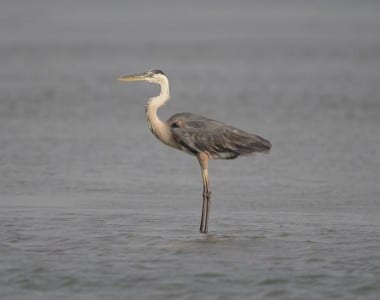
This is a Gallery for beginners, and it’s an identification exercise. Just look at the bird and try to decide what species it is. So this is number one. Scroll down.
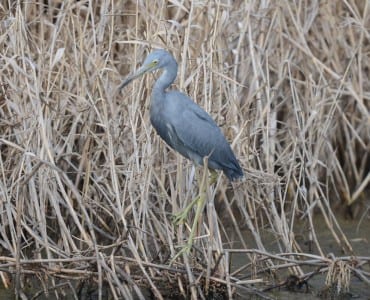
So the top one was a Great Blue Heron. Notice how they have a lot of white and other colors on them. What’s number 2 ?
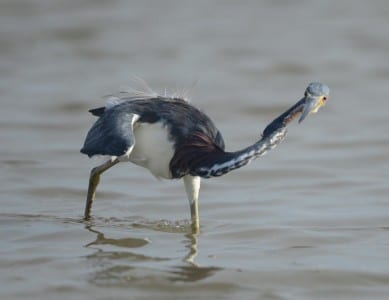
OK, the one above is a Little Blue Heron. Very dark and a two-toned bill (though this one isn’t very distinct). They are usually in freshwater, not on the coast. Now, what is #3?
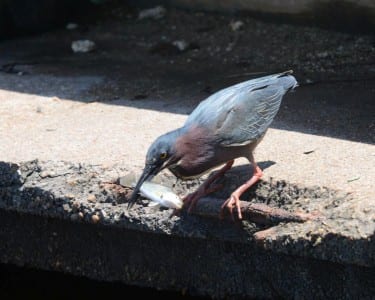
Right! The above bird is a Tri-colored Heron, once called a Louisiana Heron. The white belly gives it away but they also have a long skinny bill and neck. Now, what is the one just ?
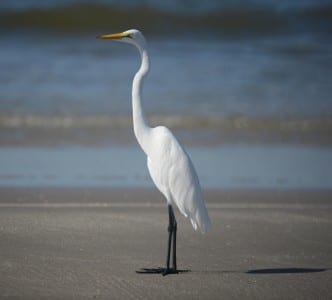
The bird above is the Green Heron, a small, rather dark heron that’s common here in the spring migration and breeds locally. Notice the bright orange legs. Now, what’s the big white one?
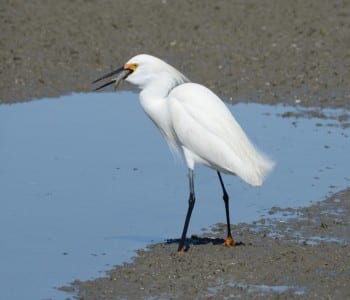
Yes, white waders make us automatically think of egrets, and this one above is the mighty Great Egret. Note the black legs and yellow bill. Now, what about this one ?
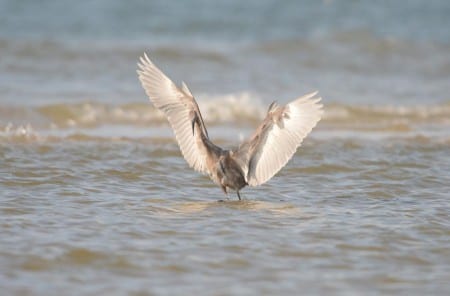
This is the beautiful Snowy Egret, with black legs and bill, p lus the “golden slippers” they are famous for. He’s got quite a mouthful! Now, what on Earth is this brownish-gray wader with his wings out?
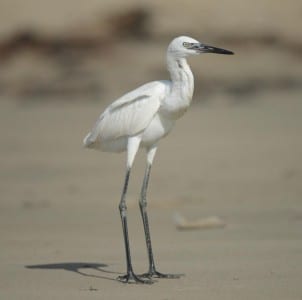
Above is the Official Island Bird, the Reddish Egret. This is an immature of the dark morph, but a bird you see a lot of in fall. Amazingly, about 15% of the Reddish Egrets are pure white. That’s not albinism, but rather a different color morph. Whatever they are hatched into, they stay that way for life. See these at FeatherFest! So what’s this?
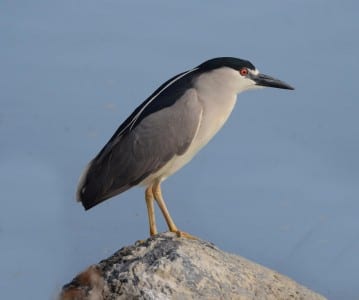
Yes, I kinda gave that one away. It’s the white morph of the Reddish Egret, also an immature. Of course, in fall, this species doesn’t have the two-toned bill or the cobaltblue legs like you’re sure to see at FeatherFest! 😉 So, what is the one?
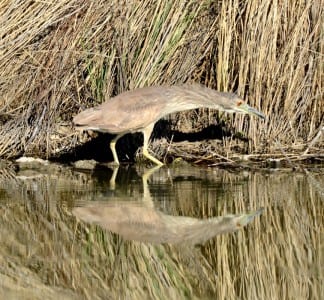
No, Mort, that’s not a Whooping Crane! That’s a Black-crowned Night-heron. This group has a stocky appearance, with short legs and a thick bill for cracking crabs and crayfish. And look at those big eyes for night vision. But what is the bird?
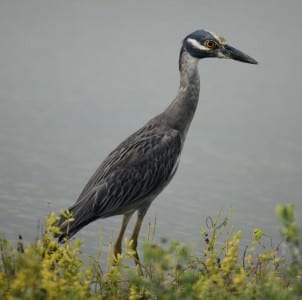
Boy, David Sibley just e-mailed and said he thought that was a Song Sparrow, but… OK, that bird is shaped like the previous BCNH but is basically brown. Short legs, yellow on the bill…it’s an immature Black-crowned Night-heron. You’ll see this species sitting out on pilings and such along the coast. But what on Earth is the one?
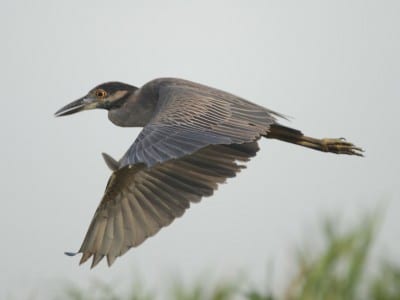
Ken Kauffman said Stripe-headed Tanager, but it’s actually a Yellow-crowned Night- Heron (without the yellow!). These are more in marshes, even roosting there, while BCNHs prefer to rest in trees and on poles. Notice the striped head and all-gray color of the adult. Immatures are found . But what is this next bird?"
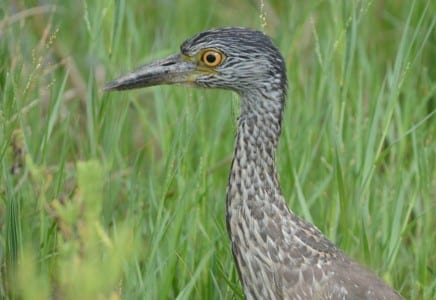
That above bird is a Yellow-crowned Night-Heron, much like the one before it. They are often seen in spring and summer near Houston, eating crayfish in ditches. Notice the big eyes, and its legs are longer than black-crowns. They stick out well beyond the tail, unlike BCNHs. OK, what is this poor bird ?
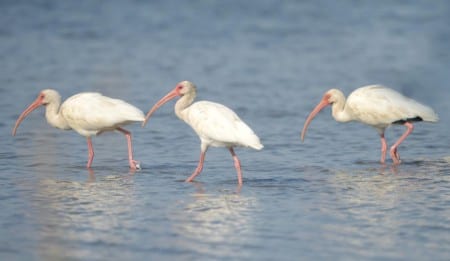
I sent this one to the Pope and he blessed it, felt its pain for not having any wealth or looks, p rayed for it but didn’t have a clue what it was*. Turns out it’s an immature Yellow-crowned Night-heron, and notice they lack any yellow in the bill. *He knows more about Cardinals, Red Bishops, Prothonotaries, Nunbirds and (I know there’s another one!).Come on guys, there’s another “Catholic” bird!!! Now, what are these ?"
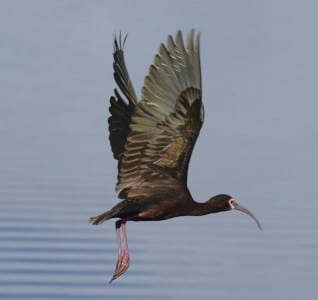
Wow, President Obama just wrote in and said these were Long-billed Pigeons, and to please get the right, sickly-looking bird to sign up for health insurance. Will do! With all due respect, though, they’re adult White Ibis, obviously that family coz of the decurved bill. They are all over the Texas Coast and inland as well. But what on Earth is the dark one ?
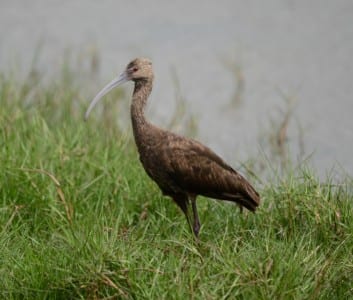
Santa Claus just e-mailed me claiming that the above bird was the North Pole Long-billed Crow, but it’s actually a White-faced Ibis. You see the white wraps around behind the eye, eliminating the Glossy Ibis, and Santa just got the bill all wrong. Maybe he’ll get the one:
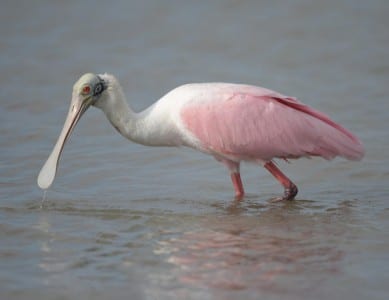
Well, Dr. O’Donell just wrote me a letter claiming this was a flamingo, and that she’dprescribe Rogaine, but I’m inclined to think that’s a bald-faced booboo. 😉 Yes, it’s aRoseate Spoonbill, and the adults really are “bald.”So, thank you for playing, and also thank you for our two bird leaders on Galveston beingsuch good sports. They’re the best! J/A, you’re next! Just kidding.
(October 22, 2013)

 Posted in
Posted in 
























